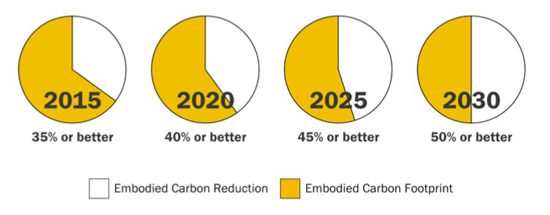Life Cycle Assessment of Building Products
Green Certifications and LCA
The growing availability and use of LCAs and EPDs as a means to assess and compare different materials and products for green buildings has led to their growing recognition as appropriate for use in different green building and product certifications. These certifications set a performance standard and act as a benchmark for what acceptable or preferred levels should be sought in regards to environmental impacts. A summary of those certifications and their incorporation of LCA is as follows:
LEED 2009
The concept of using LCAs and EPDs is not entirely new to the LEED® rating system as developed by the U.S. Green Building Council (USGBC). In the current version of LEED 2009 in the Materials and Resources (MR) category, pilot credits have been available under MRpc52 for use of an EPD in at least 20 permanently installed products in a building. This pilot credit has required at least a cradle-to-gate scope and allows the use of product-specific or industry-wide (generic) declarations. It also requires that the 20 products be sourced from at least five different manufacturers.
In addition to this pilot MR credit, Innovation in Design (ID) credits have been made available for using products with a SMaRT Certification. A Credit Interpretation Request (CIR) has been issued in regards to the SMaRT Certification, and the determination has been made by USGBC that since the certification “encourages innovation through product improvement” it is acceptable for an innovation credit provided proper documentation is provided in the LEED application. That documentation needs to show that the percentage of SMaRT certified materials must equal at least 2.5 percent of the total materials cost. The contribution to the cost analysis depends on the level of certification, with Platinum projects counting double, silver half and gold 100 percent.
LEED v4
The latest version of LEED has been in development for several years and is anticipated to be released sometime during 2013. The Materials and Resources (MR) section is proposed to have substantial revisions such that points that used to be available for regional materials and recycled content are being rolled into the points available for LCAs and EPDs. Happily, the USGBC is not asking project design teams to conduct LCAs or to become LCA experts. Instead, the project team will be able to request an EPD (or perhaps another approved form of reporting) that discloses the required LCA-based information. In essence, LEED version 4 will ask product manufacturers to gather the life cycle information on their products and to disclose relevant portions of that information in the standard EPD format. The new relevant credits affect four out of the five MR credits beyond the prerequisites and can earn up to 11 points in the process as follows:
MRc1: Building life cycle impact reduction - up to 5 points
MRc2: Building product disclosure and optimization - environmental product declarations - up to 2 points
MRc3: Building product disclosure and optimization - sourcing of raw materials - up to 2 points
MRc4: Building product disclosure and optimization - material ingredients - up to 2 points
In addition to earning points in this revamped MR section of LEED v. 4, an Innovation in Design credit remains available for use of products with SMaRT Certification.
SMaRT Sustainable Product Certification
We have mentioned this program previously, but some more specifics are worth pointing out. First, it is a consensus-based certification that has been developed by industry experts and thought leaders. It requires environmental excellence in a variety of impact categories that go beyond those required by ISO. For example, no Stockholm Chemical Persistent Organic Pollutants are allowed (CFCs, pesticides, etc.). It also requires a full LCA, energy inventory, manufacturer social indicator reporting, and indications on product durability. Qualification points are earned in each of the categories and levels of recognition obtained accordingly.
Note that under the SMaRT program, EPDs alone are not a statement of environmental superiority. Instead they are statements of transparency that show quantification of the environmental impacts of a product. SMaRT Certification is, however, recognized as a statement of environmental superiority due to its extremely rigorous and comprehensive requirements. In serving as a general-purpose PCR, it also defines how products can be classified and reported under an EPD:
- Type I: Environmentally preferable product—product environmental superiority
- Type III: ISO-compliant LCA EPD—product transparency
Depending on the number of points that are earned, the further designations of sustainability are conferred (i.e., Sustainable, Sustainable Silver, Sustainable Gold, or Sustainable Platinum).
Architecture 2030 Challenge for Products
The Architecture 2030 organization is known for its call to action by architects and others to reduce the use of fossil fuels in buildings down to zero by the year 2030. That's the year by which climate scientists tell us we need to make radical progress with respect to reducing the amount of carbon we emit into the atmosphere if we want to be able to mitigate climate change. Therefore, the embodied carbon footprint of building materials and products is also an important part of the needed action. The Architecture 2030 Challenge for Products focuses solely on reducing carbon footprint compared to a product category average. It recognizes that elimination is not realistic but calls for cutting the carbon footprint of products fully in half by the year 2030. Obviously, the use of LCA and EPDs are the way to objectively and fully gauge the progress any product manufacturer is making in that regard and therefore can inform architects and others when seeking to specify products with the lowest carbon footprint.
 |
The Architecture 2030 Challenge for Products calls for a reduction in the carbon footprint of building products compared to the average in their category over the next 17 years. Chart courtesy of Architecture 2030 |









